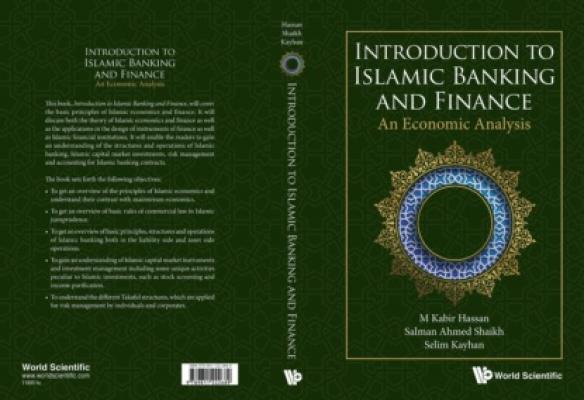Introduction to Islamic Banking and Finance. M Kabir Hassan
Читать онлайн.| Название | Introduction to Islamic Banking and Finance |
|---|---|
| Автор произведения | M Kabir Hassan |
| Жанр | Банковское дело |
| Серия | |
| Издательство | Банковское дело |
| Год выпуска | 0 |
| isbn | 9789811222702 |
INTRODUCTION TOISLAMIC BANKINGAND FINANCE An Economic Analysis
M Kabir Hassan
University of New Orleans, USA
Salman Ahmed Shaikh
SZABIST University, Pakistan
Selim Kayhan
Necemettin Erbakan University, Turkey
Published by
World Scientific Publishing Co. Pte. Ltd.
5 Toh Tuck Link, Singapore 596224
USA office: 27 Warren Street, Suite 401-402, Hackensack, NJ 07601
UK office: 57 Shelton Street, Covent Garden, London WC2H 9HE
Library of Congress Cataloging-in-Publication Data
Names: Hassan, Kabir, author. | Shaikh, Salman Ahmed, author. | Kayhan, Selim, author.
Title: Introduction to Islamic banking and finance : an economic analysis / M. Kabir Hassan, University of New Orleans, USA, Salman Ahmed Shaikh,
SZABIST University, Pakistan, Selim Kayhan, Necemettin Erbakan University, Turkey.
Description: New Jersey : World Scientific, [2020] | Includes bibliographical references and index.
Identifiers: LCCN 2020028767 | ISBN 9789811222689 (hardcover) |
ISBN 9789811224218 (paperback) | ISBN 9789811222696 (ebook) |
ISBN 9789811222702 (ebook other)
Subjects: LCSH: Finance--Islamic countries. | Finance--Religious aspects--Islam. |
Banks and banking--Islamic countries. | Banks and banking--Religious aspects--Islam.
Economics--Religious aspects--Islam.
Classification: LCC HG187.4 .H396 2020 | DDC 332.0917/67--dc23
LC record available at https://lccn.loc.gov/2020028767
British Library Cataloguing-in-Publication Data
A catalogue record for this book is available from the British Library.
Copyright © 2021 by World Scientific Publishing Co. Pte. Ltd.
All rights reserved. This book, or parts thereof, may not be reproduced in any form or by any means, electronic or mechanical, including photocopying, recording or any information storage and retrieval system now known or to be invented, without written permission from the publisher.
For photocopying of material in this volume, please pay a copying fee through the Copyright Clearance Center, Inc., 222 Rosewood Drive, Danvers, MA 01923, USA. In this case permission to photocopy is not required from the publisher.
For any available supplementary material, please visit
https://www.worldscientific.com/worldscibooks/10.1142/11895#t=suppl
Desk Editors: Balamurugan Rajendran/Karimah Samsudin
Typeset by Stallion Press
Email: [email protected]
Printed in Singapore
Foreword
Islamic banking and finance is an estimated $2.6 trillion dollar industry as of the end of 2018 with major footsteps in the Middle East, South Asia, East Asia, Far East, North Africa, and Europe. After the global financial crisis of 2007–2009, this nascent field has exhibited resilience, stability, and strong growth. The economic and sound commercial competitiveness alone has generated interest in the use of Islamic finance instruments as alternate finance. The principles of risk-sharing, financial transparency, and responsible use of funds for identified asset acquisition have increased its appeal as a form of ethical and socially responsible finance.
This book covers the basic principles of Islamic economics and finance. It discusses both the theory of Islamic economics and finance as well as the applications in the design of instruments of finance as well as Islamic financial institutions. It enables the readers to gain an understanding of the structures and operations of Islamic banking, Islamic capital market investments, and risk management for Islamic banking contracts.
The book sets forth the following objectives:
•To get an overview of the principles of Islamic economics and understand their contrast with mainstream economics.
•To get an overview of the basic rules of commercial law in Islamic jurisprudence.
•To get an overview of basic principles, structures, and operations of Islamic banking both in the liability-side and asset-side operations.
•To gain an understanding of Islamic capital market instruments and investment management including some unique activities peculiar to Islamic investments, such as stock screening and income purification.
This book features chapters covering Islamic finance products and their applications. The book highlights how the distinguishing features in Islamic finance do not hamper the economic purpose in most product structures, thus, it makes a strong case for using it to enable access to finance in developing countries, foster financial inclusion of voluntarily excluded faith-conscious people, and to bring competitiveness in the financial industry.
The book is focused on the theoretical and academic treatment of Islamic finance theory and practice. It does not get into jurisprudential debates within Islamic banking product developers and regulators. Rather, it presents the mainstream consensus in theory and practice with well-supported mainstream literature and the latest statistics.
The text avoids the normative discussions and evaluation of arguments in issues which are less well settled and agreed upon in the research literature. It focuses on the mainstream theory and practice and elaborates it for the audience who is interested to know about Islamic banking and finance the way it is being practiced. The book provides a global perspective on Islamic finance instruments, especially those that are applied in the financial industry currently.
The book is beneficial to academicians, researchers, practitioners, and legal experts who wish to get a global perspective on Islamic banking and finance products and their contemporary applications. The updated content makes the information useful for pedagogical purposes in training and academic programmes. The book is beneficial to be used in Islamic banking and finance courses in academia and executive learning programmes that cover Islamic banking and finance practice.
Among the individual readers, the book will be useful to practitioners, academicians, legal experts, and university students, especially those majoring in finance, accountancy, and law. This book can also be used as a reference text in these courses, such as:
•Fundamentals of Islamic Banking and Finance
•Applied Islamic Banking and Finance
•Risk Management in Islamic Banking
•Islamic Capital Markets and Investments.
The book attempts to provide an exposition to the research and practice in the area of Islamic banking and finance. The chapters and the contents are organized and adequately elaborated for a variety of technical and non-technical audiences in academia and industry.
Lastly, we would like
